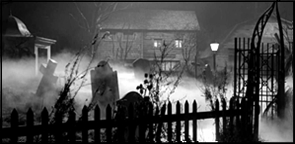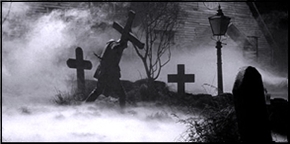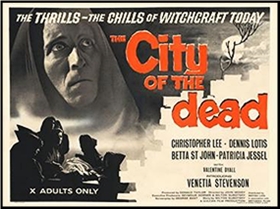Sun 6 Sep 2020
A Horror Movie Review by Jonathan Lewis: THE CITY OF THE DEAD (1960).
Posted by Steve under Horror movies , Reviews[2] Comments

THE CITY OF THE DEAD. Vulcan Films, UK, 1960. Trans-Lux, US, 1962, as Horror Hotel. Christopher Lee, Patricia Jessel, Betta St. John, Venetia Stevenson, Dennis Lotis, Valentine Dyall. Written by George Baxt and Milton Subotsky. Directed by John Moxey. Easily found on YouTube, among other sources, including Amazon Prime.
A decade before John Llewellyn Moxey directed The Night Stalker (1972), he, under the name John Moxey, honed his skills in the supernatural genre with The City of the Dead, aka Horror Hotel (reviewed here earlier on this blog by Dan Stumpf).
Beautifully filmed in crisp black and white with an ongoing visual sense of impending menace, the movie draws upon New England witchcraft lore to tell a tragic tale of what happens when one gets too fascinated by the darkness.
WARNING: Possible Spoilers Ahead. Eager and intrepid college student Nan Barlow (Venetia Stevenson), intrigued by her professor’s lecture on witch burnings seeks to do further research on the morbid topic. Little does she know that her professor, one Alan Driscoll (Christopher Lee) is himself a purveyor of the dark arts. In a twist that would be repeated with greater effect and recognition that same year in Alfred Hitchcock’s Psycho (1960), the first act of the film follows the would-be protagonist from a relatively secure setting to a hotel where she will meet her doom.

But unlike in Psycho where the killer is a human, albeit a tremendously disturbed one, in The City of the Dead, the killers are very much empowered by a dark, supernatural force. As it turns out, when the good people of the fictional hamlet of Whitewood, Massachusetts, burned a witch at the stake in 1692, they didn’t actually kill her so much as curse their own descendants for all eternity.
The witch (Patricia Dressel) that they thought they had put to death is very much alive. And in 1960, she’s the proprietor of the Raven Inn, the “horror hotel.†As in Psycho, it’s up to others to figure out what happened to a beautiful young woman who mysteriously disappeared at a hotel. Here, it is Nan’s brother and her boyfriend team who up to solve the puzzle and defeat the coven of witches responsible for the co-ed’s murder.

There’s a particular aesthetic to The City of the Dead that makes it a stronger and more compelling film than its rather clumsy sets and relatively short running time would suggest. The witch burning sequence at the beginning is top notch. So is the final sequence set in a graveyard. There’s definitely a letdown of dramatic tension in the second act, but this only makes the tense scenes that much more visceral. For his part, Lee puts in a strong performance, but it’s nowhere near his best nor most memorable.
Still, this is an overall enjoyable horror film that is worth a look this upcoming Halloween season. One final note. The film contains a seemingly incongruous jazz score. One would think that it would be horribly out of place in such a macabre film. But it works quite effectively in reminding the viewer of the era in which the movie was made. And, for those of us who enjoy early 1960s British horror films, movies that were just a little more innocent than the color horror films of the 1970s, that’s not such a bad thing.

September 6th, 2020 at 8:51 pm
A fine little horror film with a literate screenplay by Baxt. The film’s basic structure almost certainly was borrowed from PSYCHO, but not unknown in some Gothic fiction either, and this has a very Gothic feel to it. Like BURN WITCH BURN (NIGHT OF THE EAGLE) based on Fritz Leiber’s CONJURE WIFE this is as much about atmosphere and suspense as scares and boos with rather more character development than later more obvious British horror.
September 6th, 2020 at 9:27 pm
As much of a fan of the color Hammer films as I am, I really think I like the black and white horror films of this earlier era better. Even PSYCHO was the better for it.